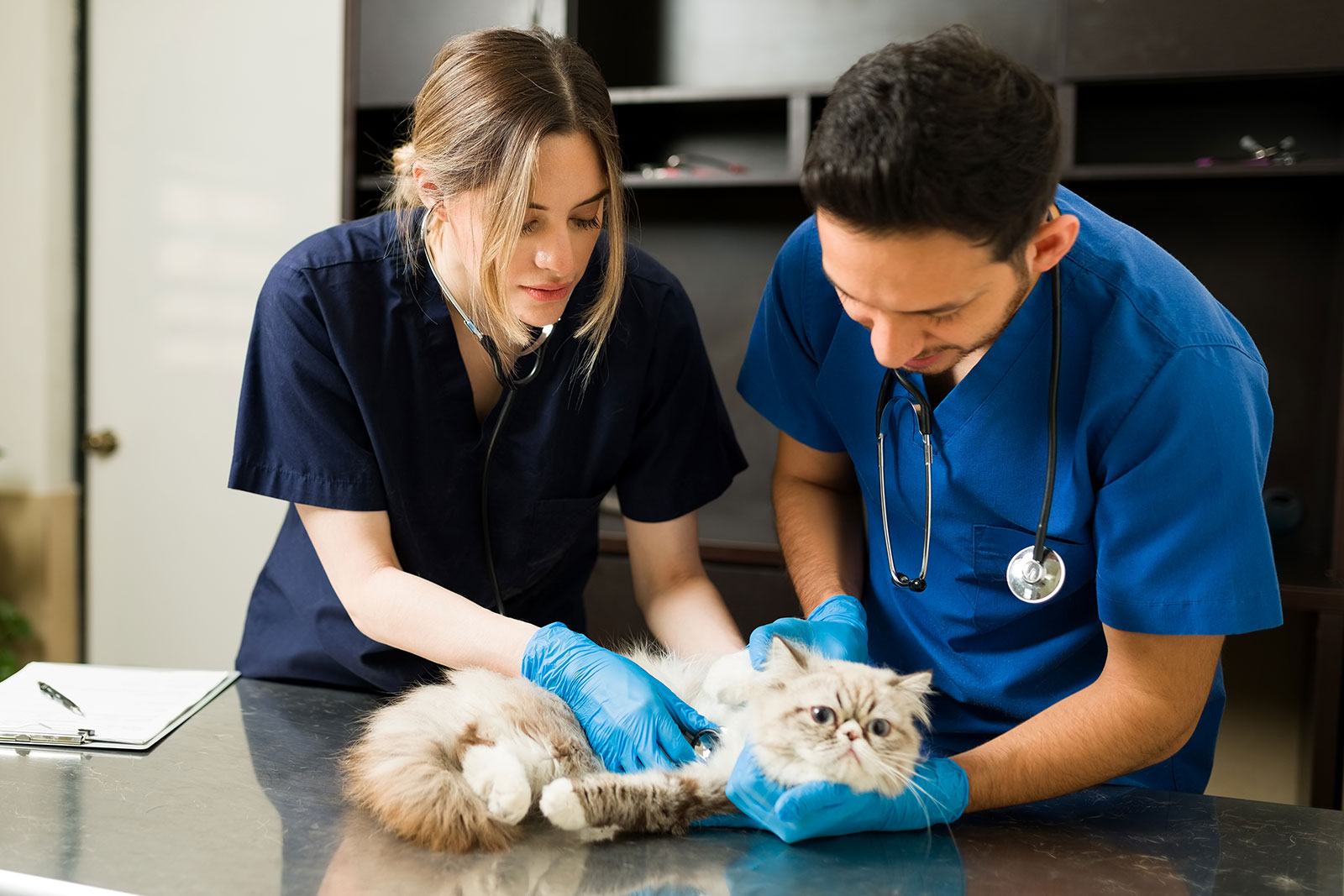Pyothorax in Dogs – Pyothorax is a severe condition affecting dogs. This medical condition is also called thoracic empyema. Pyothorax means infected (pus) fluid is present in the pleural cavity (the space between the lungs and chest wall). The presence of pus can occur due to a bacterial infection, which may lead to difficulty breathing and systemic illness. Without treatment, pyothorax can be fatal. In this blog, we will discuss the causes and clinical signs of Pyothorax in Dogs, the diagnostic workup overview, treatment options, and what to expect in the recovery process when a dog is diagnosed with pyothorax.

What Causes Pyothorax in Dogs?
Pyothorax is most commonly caused by bacterial infection in the chest cavity. Bacteria can enter the pleural space in many ways –
Penetrating Chest Injuries – Bite wounds or gunshot wounds, or other trauma can allow bacteria direct access to the pleural space.
Migrating Foreign Bodies – Grass awns or other plant material inhaled into the lungs can migrate into the chest cavity and introduce bacteria.
Pneumonia or Lung Abscesses – A severe infection in the lungs can spread into the pleural cavity, which can lead to a large area of purulent (pus fluid) fluid accumulation.
Surgical or Medical Procedures – Rarely, complications from surgery or placement of a chest tube may be infectious.
Hematogenous Spread – Microbes in the circulation may be localized in the pleural space, particularly in infected/immunocompromised dogs.
Dogs with hunting and sporting characteristics may have a more increased risk due to the outdoors, field/mountain, organ, and inhale, which could be exposed to plant materials.
Symptoms of Pyothorax in Dogs
Symptoms of Pyothorax vary depending on infection severity and progression. Some common symptoms are –
- Labored or rapid breathing
- Open-mouth breathing
- Lethargy and weakness
- Fever
- Coughing or gagging
- Loss of appetite
- Weight loss
- Not lying down or restlessness
In the most extreme conditions, dogs may collapse, showing diminished consciousness and/or cyanosis (bluing of the gums), indicating a profound lack of oxygen. An owner observing pulmonary distress may often notice distension of the thorax, abnormal sounds in respiration, and sensitivity to palpation around the chest. In some cases, the infection may progress to septicemia, which may have grave consequences for the dog.
How Is Pyothorax Diagnosed?
Timely diagnosis is critical to engage in appropriate treatment protocols. A veterinarian will first conduct a complete examination of the patient. A veterinary technician will often ask about the patient’s medical history. The veterinarian will then carry out appropriate diagnostic tests. The following are important diagnostic tools –
Chest X-Rays (Thoracic Radiographs) – X-Rays may demonstrate the presence of fluid accumulation in the pleural space, as well as demonstrate some lung changes in volume or opacity.
Thoracocentesis or Chest Tap – It is when a sterile needle is passed into the chest wall and fluid is withdrawn for further study. The presence of cloudy, malodorous, or purulent fluid is highly suggestive of pyothorax.
Cytology and Culture – Samples of fluid to be analyzed microscopically and cultured to identify the perpetrating bacteria for targeted antibiotic therapy.
Ultrasound – Ultrasound of the thorax may be of value in guiding chest taps to visualize any pockets of fluid or abscesses.
Complete Blood Count (CBC) and Biochemistry Profile – CBC and biochemistry profiles target any evidence regarding the overall health status, organ function, and extent of the infection.
In instances of a foreign body suspected, CT scans may be required to both diagnose and assess surgical options.
Therapeutic Options for Pyothorax in Dogs
The overall aim of treatment for pyothorax is the removal of infected fluid, eradication of any bacterial infection, and patient support for successful recovery.
Fluid Removal
Initial thoracocentesis will relieve pressure and provide some comfort to aid the patient’s ability to breathe. If fluid remains in the pleural space and continues to accumulate, the dog may require a chest tube to allow drainage and allow routine flushing of the pleural space.
Antibiotic Therapy
Initially, the patient will have broad-spectrum IV antibiotic therapy started. Antibiotic therapy may change after culture and sensitivity results are returned for the pleural fluid.
Oxygen Therapy
Oxygen therapy may be required to stabilize the dog if they are in distress with breathing.
Surgical Intervention
If there is a foreign body, lung lobe necrosis, or if the infection does not respond to medical management, then surgical intervention may be warranted. Procedures such as a thoracotomy (opening the thorax) will allow for drainage, foreign body removal, and lung lobe resection as warranted.
Supportive Care
IV fluids for hydration, analgesia, nutritional support, and close monitoring will be important during recovery.
Early and aggressive treatment can influence survival.
Prognosis & Recovery
The prognosis for a dog diagnosed with pyothorax is variable, largely dependent on infection stage, cause or reason for infection, and prompt treatment initiation. Many dogs can make a good recovery when prompt medical treatment is provided.
- Mild to moderate cases that are managed through chest drainage and antibiotics have a good prognosis.
- Severely infected dogs or chronically infected dogs that require surgery will tend to have more guarded prognoses, but have a reasonably good chance of recovery.
- Recurring pyothorax is possible, especially if the reason for pyothorax is never diagnosed or treated.
Recovery can take several weeks, and the owner can expect multiple appointments to monitor progress, have chest tubes removed, and adjust medications. Owners should ensure their dog receives a full course of prescribed antibiotics, typically, 4–6 weeks. Dogs should have their activity restricted during recovery.
Conclusion
Pyothorax in dogs is a potentially life-threatening condition that requires immediate veterinary attention. If your dog appears to be breathing with difficulty, lethargic, or shows signs of discomfort in his chest, don’t wait; seek veterinary care immediately. Acting promptly could save your dog’s life!
FAQs
Can pyothorax in dogs be prevented?
Not all cases of pyothorax may be preventable, but you can limit your dog’s risk by reducing your dog’s exposure to high-risk environments, treating respiratory infections and chest injuries promptly, providing routine veterinary care, and preventing your dog from being bitten by aggressive dogs.
Is pyothorax contagious to other pets and humans?
Pyothorax is generally considered not contagious. However, if the pyothorax is due to the presence of certain zoonotic bacteria, it is advisable to follow basic hygiene practices like washing your hands after handling the pet. Other household pets do not typically contract disease.
Can dogs lead normal lives after recovering from pyothorax?
Yes, the majority of dogs will return to a normal, healthy life after successful treatment. Overall, long-term outcomes are more favorable when conditions are diagnosed more quickly and the underlying cause is examined. So long as the dog is carefully monitored for any signs of pyothorax and attempts to eliminate risk factors, there should be no recurrence.




